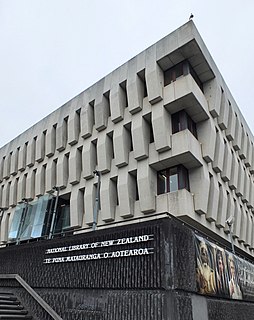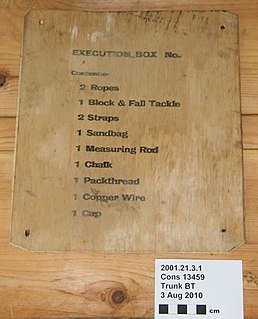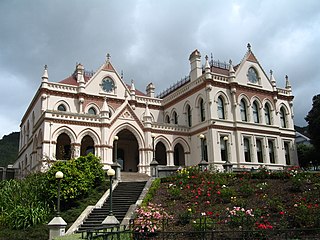
Victoria University of Wellington is a university in Wellington, New Zealand. It was established in 1897 by Act of Parliament, and was a constituent college of the University of New Zealand.

Wellington is the capital city of New Zealand. It is located at the south-western tip of the North Island, between Cook Strait and the Remutaka Range. Wellington is the major population centre of the southern North Island, and is the administrative centre of the Wellington Region, which also includes the Kapiti Coast and the Wairarapa. It is the world's southernmost capital of a sovereign state. Wellington features a temperate maritime climate, and is the world's windiest city by average wind speed.
Wellington College of Education was established in 1888 with the purpose of educating teachers in New Zealand. It became the Faculty of Education of Victoria University of Wellington, formed from the School of Education of the University, and the Wellington College of Education on 1 January 2005.

The National Library of New Zealand is New Zealand's legal deposit library charged with the obligation to "enrich the cultural and economic life of New Zealand and its interchanges with other nations". Under the Act, the library's duties include collection, preserving and protecting the collections of the National Library, significant history documents, and collaborating with other libraries in New Zealand and abroad.

William Gray Young was a New Zealand architect in the early 20th century, designing buildings such as Knox College in Dunedin, the Wellington railway station and Wellington's Elliott House. He was president of the New Zealand Institute of Architects from 1935 to 1937.

The Remutaka Range is the southernmost range of a mountain chain in the lower North Island of New Zealand. The chain continues north into the Tararua, then Ruahine Ranges, running parallel with the east coast between Wellington and East Cape.

New Zealand Parliament Buildings house the New Zealand Parliament and are on a 45,000 square metre site at the northern end of Lambton Quay, Wellington. They consist of the Edwardian neoclassical-style Parliament House (1922); the Parliamentary Library (1899); the executive wing, called "The Beehive" (1977); and Bowen House, in use since 1991. Whilst most of the individual buildings are outstanding for different reasons, the overall setting that has been achieved "has little aesthetic or architectural coherence".

Capital punishment in New Zealand, the process of sentencing convicted offenders to death for the most serious crimes and carrying out that sentence, as ordered by a legal system, first appeared in a codified form when New Zealand became a British colony in 1840. It was first carried out with a public hanging in Victoria St, Auckland in 1842, while the last execution occurred in 1957 at Mount Eden Prison, also in Auckland. In total, 85 people have been executed in New Zealand.

Frankton is a central suburb of the city of Hamilton, New Zealand. It is the site of the city's passenger railway station, a major industrial-commercial stretch of State Highway 1, and a commercial shopping area. Frankton Borough Council was formed in 1913, but merged with Hamilton in 1917, after a poll in 1916.

Old St Paul's is a historic site, a city landmark and a wedding and event venue in the heart of Wellington, the capital city of New Zealand. The building served a dual role as the parish church of Thorndon and the pro-cathedral of the Diocese of Wellington of the Anglican Church between 1866 and 1964. It exemplifies 19th-century Gothic Revival architecture adapted to colonial conditions and materials, and stands at 34 Mulgrave Street, Pipitea, close to Parliament Buildings.

Hamilton East is a suburb in central Hamilton in New Zealand. The suburb's primary commercial and retail precinct is located along Grey Street. Hamilton East is characterised by villas and bungalows built early in the 20th century.

The New Zealand Electronic Text Collection is a freely accessible online archive of New Zealand and Pacific Islands texts and heritage materials that are held by the Victoria University of Wellington Library. It was named the New Zealand Electronic Text Centre until October 2012.

Northland is an affluent suburb in west-central Wellington, New Zealand. Not far from Victoria University it also includes low-priced accommodation popular with young students. It borders the suburbs of Highbury, Kelburn, Thorndon, Wilton, Wadestown and Karori. Northland is populated by a mix of university students, young professionals and families. Part of the area was known as Creswick until the late 19th century when new roads and building sites were developed by the landowner, C J Pharazyn, who marketed the whole area as Northland. At that time it was described in the now defunct Evening Post as "Wellington's best suburb".
Lydia Joyce Wevers was a New Zealand literary historian, literary critic, editor, and book reviewer. She was an academic at Victoria University of Wellington for many years, including acting as director of the Stout Research Centre for New Zealand Studies from 2001 to 2017. Her academic research focussed on New Zealand literature and print culture, as well as Australian literature. She wrote three books, Country of Writing: Travel Writing About New Zealand 1809–1900 (2002), On Reading (2004) and Reading on the Farm: Victorian Fiction and the Colonial World (2010), and edited a number of anthologies.

The Upper Hutt Blockhouse also known as the Wallaceville Blockhouse is a 19th-century American-style military blockhouse situated in Upper Hutt, New Zealand. One of very few such blockhouses built in New Zealand, it is preserved as a Category I historic place. It was built in late 1860 as part of a larger Stockade and was one of two Blockhouses and Stockades built in the Hutt Valley that year. It was occupied by the Hutt Battalion of the Wellington Militia from December 1860 to May 1861 without coming under hostile attack.

The Hunter Building is the original building of Victoria University of Wellington's Kelburn campus in Wellington, New Zealand. It is a major landmark in the Wellington region and closely associated and considered a symbol of the university. The distinct architecture of the building is a notable example of Edwardian Gothic-revival, with red brick and Oamaru stone façade, along with grand internal entrances, staircases and original university library. The building is a noteworthy example of work from the Wellington architectural practice of Penty & Blake. While opened on the 30th of March 1906, the building was not completed to its original design, but was progressively added to as the college grew. The building is named after Sir Thomas Alexander Hunter, a well regarded professor of mental science and political economy. Following the end of the Great War, northern and southern wings were added to the building, providing new teaching areas, recreational spaces and a new library.

The New Zealand Parliamentary Library, known until 1985 as the General Assembly Library, is the library and information resource of the New Zealand Parliament. The present building was completed in 1899.
Sarah Elizabeth Jackson was a New Zealand teacher, industrial school matron and manager, community leader.

William Beetham was an English-born portrait painter, who painted mainly in the United Kingdom and New Zealand. He exhibited his paintings at the Royal Academy of Arts in London (1834–53) and painted in Hamburg, Copenhagen and at the court of the Tsar in Saint Petersburg. He emigrated to New Zealand in 1855 and became a significant figure as a colonist, pastoralist and portrait artist. He had a society clientele and received commissions to paint portraits of aristocrats and national leaders, including important Māori Rangatira chiefs. Beetham's paintings are in the permanent collection of the National Portrait Gallery, London and Museum of New Zealand Te Papa Tongarewa in Wellington. He was the founder and Chair of the New Zealand Academy of Fine Arts in 1882. Mezzotint prints of Beetham's drawings are in the permanent collection of the Science Museum, London Beetham's paintings and drawings have also sold at Bonhams auction house.
Wainuioru is small rural settlement in Wellington Region, New Zealand, just east of Masterton and north of Wainuioru River.

















